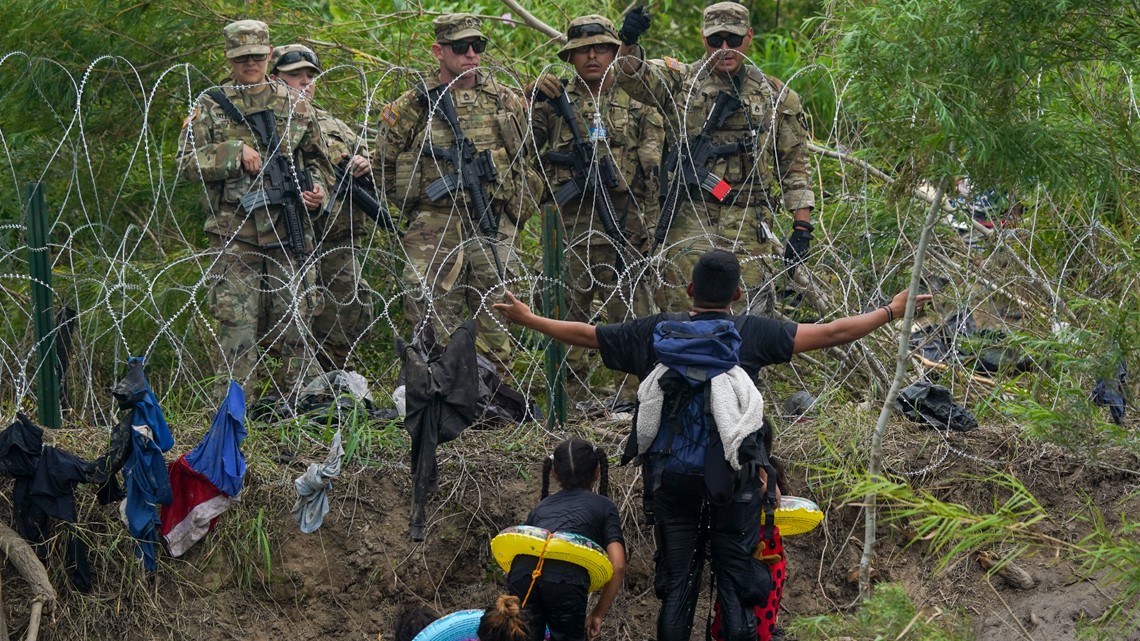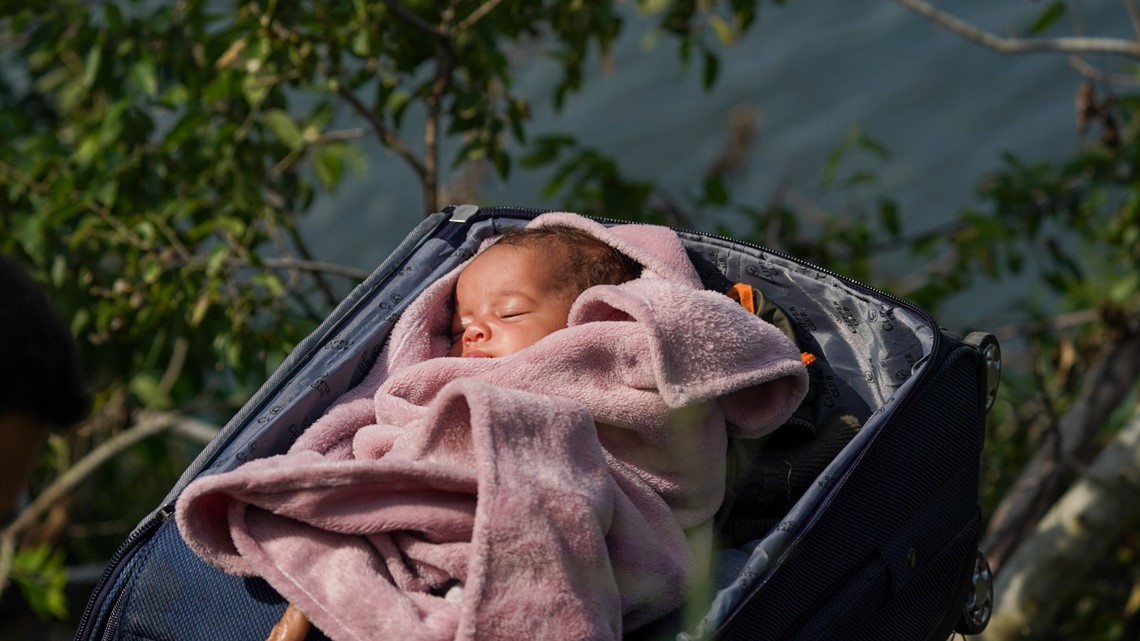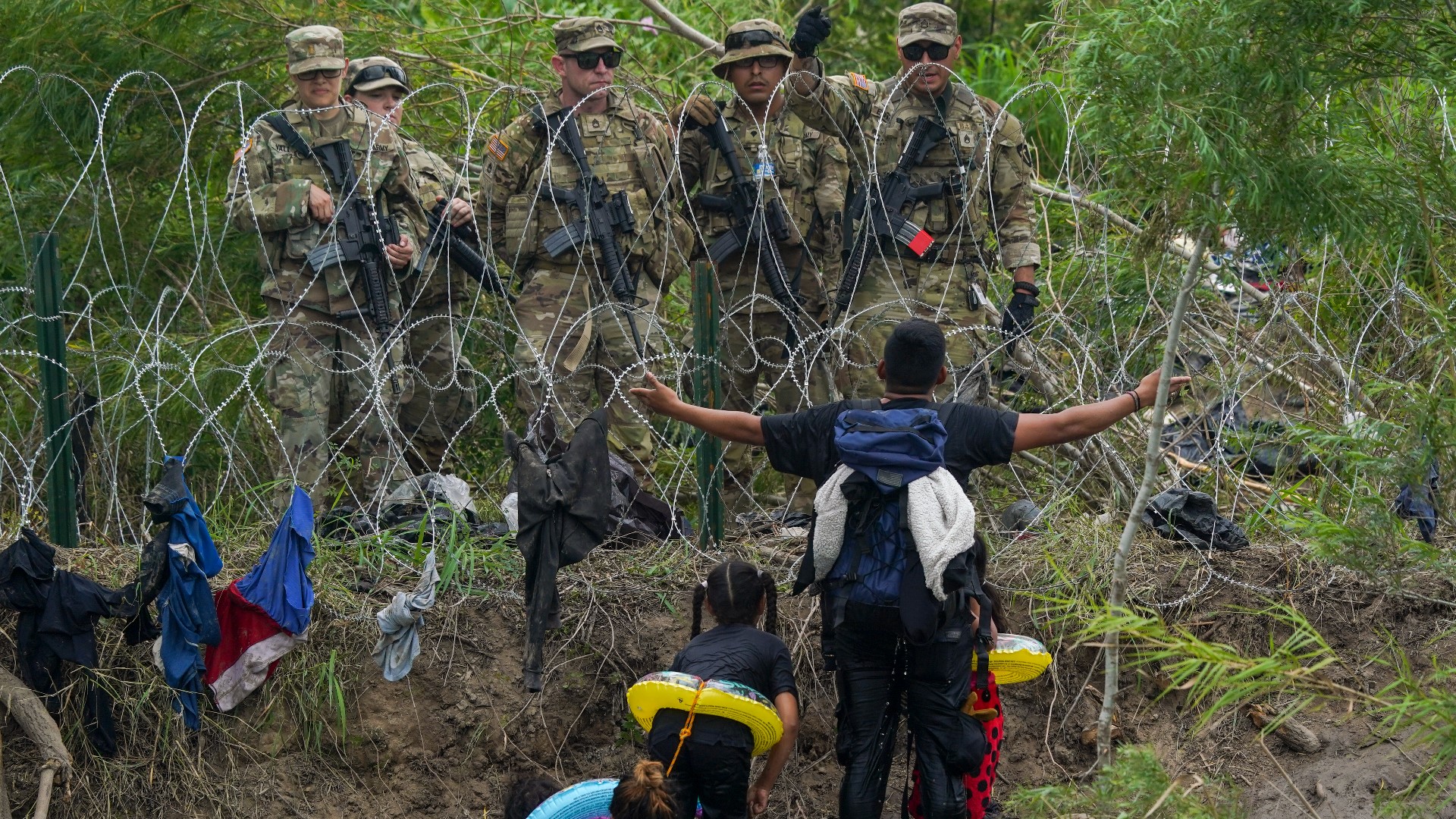MATAMOROS, Chihuahua — Migrants rushed across the Mexico border Thursday, racing to enter the U.S. before pandemic-related asylum restrictions are lifted in a shift that threatens to put a historic strain on the nation’s beleaguered immigration system.
The imminent end of the rules known as Title 42 stirred fear among migrants that the change would make it more difficult for them to stay in the U.S.
With a late-night deadline looming, migrants in Mexico shed clothing before descending a steep bank into the Rio Grande, clutching plastic bags filled with clothes. One man held a baby in an open suitcase on his head.
On the U.S. side of the river, migrants put on dry clothing and picked their way through concertina wire. Many surrendered immediately to authorities and hoped to be released while pursuing their cases in backlogged immigration courts, which takes years.
It was not clear how many migrants were on the move or how long the surge would last. By Thursday evening, the flow seemed to be slowing in some locations, but it was not clear why, or whether crossings would increase again after the restrictions expire.
A U.S. official reported that daily encounters on Tuesday hit 10,000 — nearly twice the level from March and only slightly below the 11,000 figure that authorities have said is the upper limit of what they expect after Title 42 ends.
More than 27,000 people were in U.S. Customs and Border Protection custody, the official said.
“Our buses are full. Our planes are full,” said Pedro Cardenas, a city commissioner in Brownsville, Texas, just north of Matamoros, as recent arrivals headed to locations across the U.S.
President Joe Biden's administration has been unveiling strict new measures to replace Title 42, which since March 2020 has allowed border officials to quickly return asylum seekers back over the border on grounds of preventing the spread of COVID-19.
The new policies crack down on illegal crossings while also setting up legal pathways for migrants who apply online, seek a sponsor and undergo background checks. If successful, the reforms could fundamentally alter how migrants arrive at the U.S.-Mexico border.
But it will take time to see results. Biden has conceded the border will be chaotic for a while. Immigrant advocacy groups have threatened legal action. And migrants fleeing poverty, gangs and persecution in their homelands are still desperate to reach U.S. soil at any cost.


Many migrants were acutely aware of looming policy changes as they searched Thursday for an opportunity to turn themselves over to U.S. immigration authorities.
“I don’t know what’s going to happen tomorrow,” said Jhoan Daniel Barrios, a former military police officer from Venezuela as he paced along the the border in Ciudad Juárez, across from El Paso, Texas, with two friends, looking for a chance to seek refuge in the U.S.
“We don’t have any money left, we don’t have food, we don’t have a place to stay, the cartel is pursuing us," said Barrios, whose wife was in U.S. custody. "What are we going to do, wait until they kill us?”
Last week, Barrios and his friends entered the U.S. and were expelled. They had little hope of a different result Thursday.
“Friends told me they were returned two or three times before they finally could enter,” said Osmel David Picón, who left his native Venezuela years ago and started his journey to the U.S. from Ecuador.


While Title 42 prevented many from seeking asylum, it carried no legal consequences, encouraging repeat attempts. After Thursday, migrants face being barred from entering the U.S. for five years and possible criminal prosecution.
Holding facilities along the border were far beyond capacity, and Border Patrol agents were told to begin releasing some migrants with instructions to appear at a U.S. immigration office within 60 days, according to a U.S. official who was not authorized to speak publicly about the matter and provided information to The Associated Press on condition of anonymity.
Agents were also told to start releases in any area where holding facilities were at 125% capacity or the average time in custody exceeded 60 hours. In addition, releases could begin if 7,000 migrants were taken into custody across the entire border in one day.
Homeland Security Secretary Alejandro Mayorkas warned of more crowded Border Patrol facilities to come.
“I cannot overstate the strain on our personnel and our facilities," he told reporters Thursday.
He said the vast majority of migrants would be placed in "expedited removal" proceedings and would be expelled quickly if they don't qualify to stay in the U.S. “We have confidence in the lawfulness of our actions," he said.
On Thursday, about 400 migrants huddled in strong winds whipping up the sand on the bank of the Rio Grande east of El Paso as groups of Texas National Guard soldiers constructed concertina wire barriers.
A couple from Colombia approached them asking if they could start a fire because a 10-year-old was shivering in the desert cold. Most migrants huddled together under thin blankets.
Maj. Sean Storrud of the Texas National Guard said his troops have explained to migrants the consequences of crossing illegally. “The migrants don’t really know what’s going to happen,” Storrud said.
Even as migrants were racing to reach U.S. soil before the rules expire, Mexican President Andrés Manuel López Obrador said smugglers were sending a different message. He said there had been an uptick in smugglers at his country's southern border offering to take migrants to the United States and telling them the border was open starting Thursday.
On Wednesday, Homeland Security announced a rule to make it extremely difficult for anyone who travels through another country, like Mexico, or who did not apply online, to qualify for asylum. It also introduced curfews with GPS tracking for families released in the U.S. before initial asylum screenings.
The administration says it is beefing up the removal of migrants found unqualified to stay in the U.S. on flights like those that brought nearly 400 migrants home to Guatemala from the U.S. on Thursday.
Among them was Sheidi Mazariegos, 26, who arrived Thursday with her 4-year-old son just eight days after being detained near Brownsville.
“I heard on the news that there was an opportunity to enter, I heard it on the radio, but it was all a lie,” she said. Smugglers got her to Matamoros and put the two on a raft. They were apprehended by Border Patrol agents.
Mazariegos, who said she made the trek because she is poor and hoped to reunite with her sisters living in the U.S., left her sick husband and two other children behind in Guatemala.
At the same time, the administration has introduced expansive new legal pathways into the U.S.
Up to 30,000 people a month from Haiti, Cuba, Nicaragua and Venezuela can enter if they apply online with a financial sponsor and enter through an airport. Processing centers are opening in Guatemala, Colombia and elsewhere. Up to 1,000 can enter daily though land crossings with Mexico if they snag an appointment on an online app.
In San Diego, more than 100 migrants, many of them Colombian families, slept under plastic tarps between two border walls, watched over by Border Patrol agents who had nowhere to take them for processing.
Albino Leon, 51, said the end of Title 42 prompted his family to make the journey.
“With the changes they are making to the laws, it’s now or never,” said Leon, who flew to Mexico from Colombia and got past a first border wall to reach U.S. soil.
___
Associated Press writers Colleen Long and Rebecca Santana in Washington; Christopher Sherman in Mexico City; Gerardo Carrillo in Matamoros, Mexico; Maria Verza in Ciudad Juarez, Mexico; Anita Snow in Phoenix; Nick Riccardi in Denver; Morgan Lee in Santa Fe, New Mexico; Giovanna Dell’Orto in El Paso; and Elliot Spagat in Tijuana, Mexico, contributed.

